Sue for Construction Injury St. Louis
The Risks of Construction Sites in St. Louis
Construction sites are among the most high-risk workplaces, where injuries often occur due to falls, machinery malfunctions, electric shocks, and structural breakdowns. In St. Louis, where construction is a significant field, safety failures and carelessness frequently lead to severe worker injuries. These situations not only cause corporeal harm but also monetary and mental hardship, often leaving employees unable to resume duties. Guidelines set by the Occupational Safety and Health Administration (OSHA) are meant to defend staff, but many companies fail to adhere, leading to preventable incidents. Determining who is responsible is often complex, as responsibility can fall on main builders, subcontractors, machinery suppliers, or landlords. The claims process for seeking financial recovery varies, with affected employees needing to determine between filing a insurance request or seeking a external legal case. providers often attempt to reduce payouts, making legal representation essential to ensure victims recover the damages they are deserving of.
